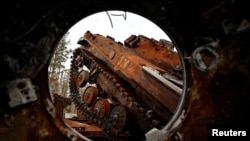Russia’s Defense Ministry said it dealt “massive” damage to Ukrainian forces in the city of Lyman, claiming to wipe out hundreds of armored vehicles and Ukrainian servicemen during a defensive battle there the first three days of October.
Russia still uses the Soviet name “Krasno-Limansky” (Red Lyman) for Lyman, a critical rail and logistics hub in eastern Ukraine’s Donetsk province. Russian Defense Ministry spokesman Igor Konashenkov told an October 3 press briefing:
“On the Krasno-Limansky direction in the area of the settlement of Slavyansk, massive fire damage was inflicted on enemy reserves."
That is misleading. Amid recent Ukrainian military advances, Russia tried to play down its retreats as a tactical move to put its forces in a more advantageous position – as if they were in control. In fact, Ukraine is pushing them out with vigor.
In early September, it was Ukraine routing Russian troops in the northern city of Kharkiv. In late September and early October, the Ukrainian advances continued with the liberation of Lyman.
Russian forces had seized Lyman on May 26, and the city remained under Russian rule last week, when the Kremlin staged elections there and other partly occupied Ukrainian provinces. President Vladimir Putin then signed papers to annex the areas.
The fighting around Lyman was fierce, according to news reports. And while there was destruction, the result was no victory for Russia. As The New York Times described it:
“In an unusually candid article published Sunday, the prominent Russian newspaper Komsomolskaya Pravda reported that in the last few days of their occupation, Russian forces in Lyman had been plagued by desertion, poor planning and the delayed arrival of reserves.
“ ‘The risk of encirclement or shameful imprisonment became too great, and the Russian command made a decision to fall back,’ a war correspondent traveling with the fleeing Russian forces wrote, adding that dispirited soldiers with ‘empty eyes’ had barely escaped Lyman with their lives.
“The retreat is a significant blow to Russian forces that could further undermine the Kremlin’s position in Donbas, a mineral-rich and fertile part of eastern Ukraine that has been central to Mr. Putin’s war aims.”
In a post-mortem titled, “ ‘What was it all for?’: recaptured Lyman left shattered by Russian occupation,” The Guardian’s Peter Beaumont documented evidence of a rapid pullout:
“It was not only equipment and personal belongings that were abandoned here. The Russians also left behind their dead to be worried by Lyman’s dogs, bodies that have been gathered by Ukrainian mortuary teams over the past three days.
“But it is along the narrow roads outside Lyman where the fighting appears to have been the most intense.
“The tarmac is holed and littered with shrapnel and missile casings, burned-out Russian armoured vehicles sit not far from blasted trenches and dugouts. Recently defused anti-tank mines are still visible in some places.”
Experts and media described Russia’s retreat from Lyman as a “most humiliating defeat” and a “major setback.”
Speaking on CBS’s “Face the Nation” program, U.S. retired Lt. Gen. H.R. McMaster said Ukraine’s victory in Lyman “could turn into a cascading series of defeats of Russian forces.”
“We might be really at the precipice of the collapse of the Russian army in Ukraine, a moral collapse. And I think they must really be at a breaking point,” said McMaster, who served as White House national security adviser during the administration of former President Donald Trump.
The Washington, D.C., think tank Institute for the Study of War said on October 3 that Ukrainian forces continued their advance on all fronts after recapturing Lyman and have crossed into Luhansk province, which Russia had fully occupied.
“The Russian units defeated on these fronts were previously considered to be among Russia’s premier conventional fighting forces,” said the ISW, which compiles its analyses from a wide range of open sources, including Russian military bloggers.
Videos appeared on social media showing surrendered Russian troops in Lyman, some cursing their command and the Kremlin for deploying them with no proper weapons, scarce ammunition and no training.
“I am blind in one eye and have medical documents to prove it. We never had medical exams,” a man wearing a Russian military uniform said in a video posted on Twitter by Christo Grozev of the investigative news site Bellingcat.
Speaking on Russian TV, Andrey Gurulyov, a Russian lawmaker, retired general and Ukraine war hawk, said he could not explain the loss of Lyman, according to a Business Insider report.
“Perhaps this is a landmark milestone, not in the military sense, but also politically,” said Gurulyov, who in the past has advocated a nuclear strike on Britain. “The problem we have is the constant delivery of good reports, or you can call it constant lying. This system does not go from bottom to the top, but top to bottom."
At that point, Gurulyov was cut off from the broadcast because of what the host called a bad connection, Newsweek said.
Russia’s Defense Ministry and state-owned media have described the retreat of Russian forces in Ukraine as “strategic regrouping” and “redeployment to more advantageous positions," while claiming that the overall “special military operation” is going “as planned.”
After Lyman, however, recognition of Russia’s military failings have started to seep through the censors and din of propaganda.
Ukraine defense officials said on October 4, that their forces destroyed more than 40 tanks as the momentum from Lyman continued. The next day, Ukraine President Volodymyr Zelenskyy shared on Twitter photographs from Lyman showing the destruction following the Russian occupation.
On October 4, the United States pledged an additional $625 million security assistance to Ukraine, including medium-range rocket systems, ammunition and armored vehicles.





